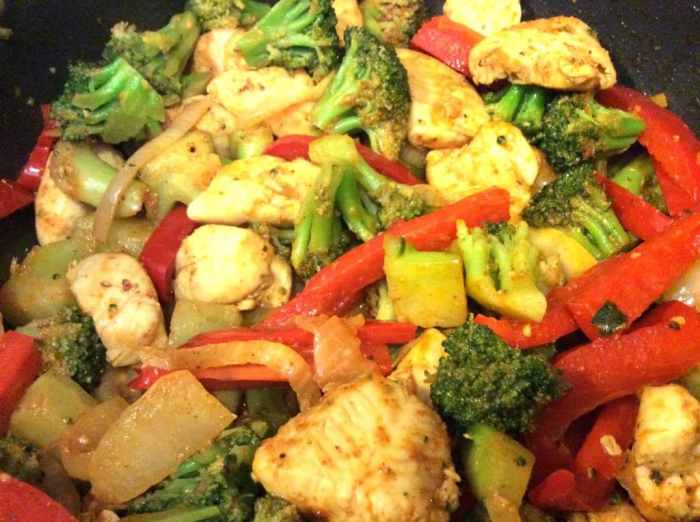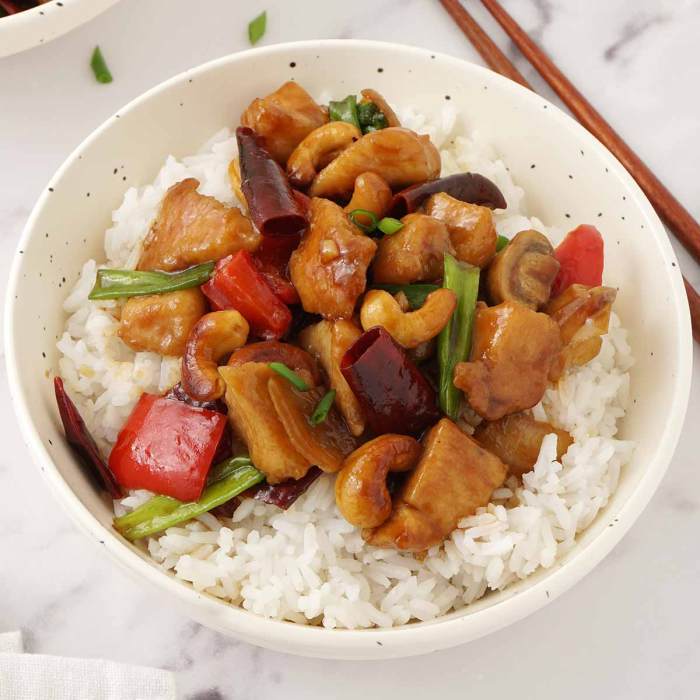Embark on a tantalizing culinary adventure with Red Curry Chicken Stir Fry with Spicy Cashew Sauce, a dish that harmonizes the bold flavors of red curry with the delectable crunch of cashew nuts. Originating from the vibrant streets of Southeast Asia, this dish has captivated taste buds worldwide with its vibrant colors, aromatic spices, and layers of flavors.
Red Curry Chicken Stir Fry with Spicy Cashew Sauce is a symphony of textures, where tender chicken mingles with crisp vegetables and crunchy cashews, all coated in a luscious red curry sauce. The heat from the chilies is balanced by the sweetness of coconut milk, creating a harmonious dance of flavors that leaves you craving more.
Red Curry Chicken Stir Fry Overview
Red curry chicken stir fry with spicy cashew sauce is a vibrant and flavorful dish that embodies the culinary traditions of Southeast Asia. It is a symphony of flavors, textures, and colors, featuring tender chicken, crisp vegetables, and a rich, aromatic sauce.
This dish has its roots in Thailand, where it is known as “gaeng phed kai.” It is believed to have originated in the central region of the country, where it is often served with jasmine rice or sticky rice. The use of red curry paste, coconut milk, and a variety of herbs and spices gives this dish its distinctive taste and aroma.
Global Popularity
Red curry chicken stir fry has gained immense popularity beyond the borders of Thailand and has become a beloved dish in many parts of the world. Its popularity can be attributed to its versatility, adaptability, and ability to cater to diverse palates.
The dish can be easily customized to suit different dietary preferences and spice levels, making it a favorite among home cooks and restaurant patrons alike.
Key Ingredients and Their Roles
Red curry chicken stir fry is a vibrant and flavorful dish that relies on a harmonious blend of fresh, high-quality ingredients to deliver its distinct taste and texture. Let’s explore the essential components and their contributions to this culinary masterpiece:
Fresh Red Curry Paste
This vibrant paste forms the heart of the dish, imparting a rich, aromatic, and slightly spicy flavor profile. Made from a combination of red chilies, lemongrass, galangal, kaffir lime leaves, and shrimp paste, it provides a complex and authentic Thai flavor.
Coconut Milk
Coconut milk adds a creamy, velvety texture and a hint of sweetness to the stir fry. It mellows out the heat from the curry paste and creates a luscious sauce that coats the chicken and vegetables.
Chicken
Tender chicken pieces are the protein base of this dish. Typically, boneless, skinless chicken breasts or thighs are used, sliced into bite-sized pieces for quick and even cooking.
Vegetables
A medley of colorful vegetables adds texture, color, and nutritional value to the stir fry. Common choices include bell peppers, bamboo shoots, carrots, snow peas, and baby corn. Their crispness complements the tender chicken and the creamy sauce.
Fresh Herbs
A sprinkling of fresh herbs, such as cilantro, basil, or Thai basil, adds a final touch of aromatic freshness and vibrancy to the dish. These herbs enhance the overall flavor profile and provide a delightful contrast to the rich sauce.
Using fresh, high-quality ingredients is paramount in creating a truly exceptional red curry chicken stir fry. Fresh curry paste ensures a vibrant flavor, while coconut milk adds a rich, creamy texture. Tender chicken, crisp vegetables, and aromatic herbs complete this symphony of flavors and textures.
Cooking Methods and Techniques

Preparing red curry chicken stir fry involves a harmonious blend of marinating, paste creation, and stir-frying techniques. Let’s explore the step-by-step process to achieve a flavorful and vibrant dish.
Marinating the Chicken
To infuse the chicken with delectable flavors, begin by marinating it in a mixture of soy sauce, oyster sauce, fish sauce, and sesame oil. This marinade tenderizes the chicken while imparting a savory and umami-rich base. Allow the chicken to marinate for at least 30 minutes, or ideally overnight, to maximize flavor absorption.
Creating the Curry Paste
The heart of the red curry lies in its aromatic paste. In a food processor or blender, combine red chili peppers, garlic, shallots, galangal, lemongrass, and kaffir lime leaves. Pulse until a smooth paste forms. Alternatively, you can use store-bought red curry paste for convenience.
Stir-Frying the Ingredients
Heat a large wok or skillet over medium-high heat. Add a generous amount of oil and swirl to coat the surface. Once the oil is shimmering, add the marinated chicken and stir-fry until golden brown and cooked through. Remove the chicken from the wok and set aside.
In the same wok, add the curry paste and stir-fry for a few minutes, releasing its fragrant oils. Pour in coconut milk and bring to a simmer. Return the chicken to the wok and stir to coat in the flavorful sauce.
Add vegetables such as bamboo shoots, bell peppers, and baby corn for a colorful and crunchy texture. Continue stir-frying until the vegetables are tender yet retain a slight crunch.
Finally, add a handful of fresh basil leaves for an aromatic touch. Serve the red curry chicken stir fry immediately over steamed jasmine rice or noodles, garnished with additional basil leaves and a sprinkle of red chili flakes for a touch of heat.
Tips for Achieving the Perfect Balance of Flavors and Textures
- Use a variety of vegetables to add color, texture, and nutritional value to the dish.
- Adjust the amount of chili peppers in the curry paste to suit your desired level of spiciness.
- For a richer and creamier sauce, use full-fat coconut milk.
- Stir-fry the vegetables quickly over high heat to retain their vibrant colors and crisp texture.
- Serve the red curry chicken stir fry immediately to enjoy the vibrant flavors and aromas at their peak.
Health Benefits and Nutritional Value
Red curry chicken stir fry offers a myriad of health benefits, attributed to its carefully selected ingredients. Let’s delve into the nutritional aspects of this delectable dish:
The primary protein source, chicken, is rich in lean protein, essential for building and maintaining muscle mass. Chicken also provides a significant amount of vitamins and minerals, including vitamin B6, niacin, selenium, and phosphorus, contributing to overall health and well-being.
Vegetables: A Symphony of Nutrients
The vibrant mix of vegetables in this stir fry is a nutritional powerhouse. Red bell peppers, with their vibrant hue, are packed with vitamin C, an antioxidant that aids in immune system function and collagen production. Broccoli florets, known for their cruciferous properties, provide ample fiber, vitamin K, and antioxidants, promoting gut health and reducing inflammation.
Baby corn and carrots add a delightful crunch and a boost of vitamins, minerals, and fiber. Baby corn is a good source of dietary fiber, which aids digestion and promotes a feeling of fullness. Carrots, rich in beta-carotene, contribute to eye health and may protect against certain types of cancer.
Herbs and Spices: Nature’s Pharmacy
The aromatic herbs and spices used in this stir fry not only enhance its flavor but also offer an array of health-promoting properties. Red curry paste, the heart of this dish, contains a blend of spices, including chili peppers, lemongrass, galangal, and kaffir lime leaves, which have antioxidant and anti-inflammatory effects.
Fresh basil, with its distinct aroma, is rich in antioxidants and may help reduce stress and improve cognitive function. Cilantro, known for its detoxifying properties, aids in the removal of heavy metals from the body.
Healthy Cooking Techniques
The stir-frying method employed in this recipe ensures that the vegetables retain their vibrant colors, nutrients, and flavors. Stir-frying involves cooking food quickly over high heat, preserving the integrity of the ingredients and minimizing nutrient loss.
Making it Even Healthier
To further enhance the healthfulness of this dish, consider the following suggestions:
- Use low-sodium soy sauce or tamari to reduce sodium intake.
- Opt for brown rice instead of white rice for a more fiber-rich option.
- Incorporate more vegetables, such as snap peas, bok choy, or mushrooms, to increase nutrient diversity.
- Use leaner cuts of chicken, such as chicken breast or thigh, to reduce saturated fat content.
By making these simple adjustments, you can create a red curry chicken stir fry that is not only delicious but also incredibly nutritious.
Variations and Adaptations

Red curry chicken stir fry is a versatile dish that can be adapted to suit different regional tastes and preferences. It can also be customized to accommodate dietary restrictions or personal preferences.
Here are some ideas for variations and adaptations:
Regional Variations
- Thai-style: This classic version of red curry chicken stir fry uses a combination of red curry paste, coconut milk, bamboo shoots, and Thai basil. The dish is typically served with jasmine rice.
- Malaysian-style: Malaysian red curry chicken stir fry often includes the addition of tamarind, pineapple, and galangal. The dish is typically served with steamed rice or roti canai.
- Vietnamese-style: Vietnamese red curry chicken stir fry is often made with a combination of red curry paste, coconut milk, lemongrass, and kaffir lime leaves. The dish is typically served with rice noodles or vermicelli.
Customizing the Dish
- Adjust the heat level: The spiciness of the dish can be adjusted by using more or less red curry paste. For a milder dish, use a mild or medium-heat curry paste. For a spicier dish, use a hot or extra-hot curry paste.
- Add vegetables: Additional vegetables can be added to the stir fry to make it a more complete meal. Some good options include bell peppers, broccoli, carrots, and snap peas.
- Use different proteins: Chicken is the most common protein used in red curry chicken stir fry, but other proteins can be used as well. Some good options include shrimp, tofu, and beef.
- Serve with different sides: Red curry chicken stir fry can be served with a variety of sides, including rice, noodles, or roti canai. It can also be served with a side of vegetables or salad.
Alternative Ingredients and Cooking Methods
- Red curry paste: If you don’t have red curry paste on hand, you can make your own using a combination of red chilies, lemongrass, galangal, and kaffir lime leaves. You can also use a store-bought curry paste, but be sure to choose one that is made with high-quality ingredients.
- Coconut milk: If you are allergic to coconut milk, you can use a dairy-free alternative, such as almond milk or soy milk. You can also use a combination of coconut milk and water.
- Stir-frying: Red curry chicken stir fry is traditionally cooked in a wok, but it can also be cooked in a large skillet or saucepan. If you don’t have a wok, be sure to use a pan that is large enough to accommodate all of the ingredients.
Presentation and Serving Suggestions
Elevate the presentation of your Red Curry Chicken Stir Fry to create a visually appealing and appetizing meal that delights your senses.
Experiment with different serving styles to make your dish stand out. Consider serving it in individual bowls or on a large platter for sharing. You can also use a bamboo steamer or a bed of jasmine rice to add height and texture to your dish.
Garnishes and Accompaniments
- Enhance the flavors and textures of your stir fry with a variety of garnishes and accompaniments.
- Fresh herbs such as cilantro, basil, or mint add a pop of color and a refreshing aroma to the dish.
- Roasted peanuts or chopped cashews provide a crunchy texture and a nutty flavor.
- A squeeze of lime juice adds a bright acidity that balances the richness of the curry sauce.
- Serve the stir fry with a side of steamed rice or flatbread for a complete meal.
Visual Appeal
- Create a visually stunning dish by arranging the chicken, vegetables, and sauce in a colorful and appealing manner.
- Consider using contrasting colors to make the dish more vibrant, such as red bell peppers, green onions, and white jasmine rice.
- Drizzle the stir fry with a glossy sauce to add shine and make it look more appetizing.
- Garnish the dish with fresh herbs, roasted peanuts, and a sprinkle of chili flakes for a touch of heat and visual interest.
Recipe Development
Organizing a detailed recipe is crucial to ensure a successful cooking experience. A well-structured recipe provides clear instructions, precise measurements, and cooking times, making it easier for home cooks to follow and achieve the desired results.
Ingredients and Measurements
Before starting, gather all the necessary ingredients and ensure you have the correct measurements. For this red curry chicken stir fry, you’ll need:
- 1 pound boneless, skinless chicken breasts or thighs, cut into 1-inch pieces
- 1 tablespoon vegetable oil
- 1 tablespoon red curry paste
- 1 can (13.5 ounces) coconut milk
- 1/2 cup chicken broth
- 1/2 cup bamboo shoots, sliced
- 1/2 cup red bell pepper, sliced
- 1/2 cup snow peas
- 1/4 cup chopped cilantro
- 1 tablespoon lime juice
- Salt and pepper to taste
Step-by-Step Instructions
1. Preparation
Cut the chicken into bite-sized pieces and set aside. Measure and prepare all the other ingredients.
2. Cooking the Chicken
Heat the oil in a large skillet or wok over medium-high heat. Add the chicken pieces and cook until browned on all sides. Remove the chicken from the skillet and set aside.
3. Making the Sauce
Add the red curry paste to the skillet and cook for a minute, stirring constantly. Pour in the coconut milk and chicken broth and bring to a simmer.
4. Adding Vegetables
Return the cooked chicken to the skillet along with the bamboo shoots, red bell pepper, and snow peas. Stir well to combine.
5. Seasoning and Finishing
Season with salt and pepper to taste. Simmer for 5-7 minutes, or until the vegetables are tender. Remove from heat and stir in the chopped cilantro and lime juice.
6. Serving
Serve the red curry chicken stir fry immediately over steamed rice or noodles. Garnish with additional cilantro if desired.
Last Recap

Red Curry Chicken Stir Fry with Spicy Cashew Sauce is a culinary masterpiece that embodies the essence of Southeast Asian cuisine. Its vibrant flavors, captivating textures, and health benefits make it a dish that will continue to tantalize taste buds for generations to come.
Whether you’re a seasoned foodie or a home cook seeking new culinary adventures, this dish promises an unforgettable gastronomic experience.
Helpful Answers
What is the origin of Red Curry Chicken Stir Fry with Spicy Cashew Sauce?
Red Curry Chicken Stir Fry with Spicy Cashew Sauce originated in Southeast Asia, particularly in countries like Thailand, Cambodia, and Laos. It is believed to have evolved from traditional stir-fry dishes and incorporates the region’s distinct flavors and ingredients.
What are the key ingredients in Red Curry Chicken Stir Fry with Spicy Cashew Sauce?
The essential ingredients include chicken, red curry paste, coconut milk, vegetables (such as bell peppers, bamboo shoots, and carrots), cashew nuts, and various seasonings. The red curry paste is a blend of aromatic spices, herbs, and chilies that gives the dish its characteristic flavor and color.
How can I make Red Curry Chicken Stir Fry with Spicy Cashew Sauce healthier?
To make the dish healthier, you can use leaner cuts of chicken, reduce the amount of oil used for stir-frying, and incorporate more vegetables. You can also opt for low-sodium soy sauce and use fresh, organic ingredients whenever possible.
What are some regional variations of Red Curry Chicken Stir Fry with Spicy Cashew Sauce?
There are various regional variations of this dish. In Thailand, it is commonly known as “Gaeng Phed Gai” and often includes ingredients like kaffir lime leaves and galangal. In Cambodia, it is called “Samlor Kari” and may incorporate lemongrass and prahok (fermented fish paste).
In Laos, it is known as “Larb Gai” and is typically served with sticky rice.



